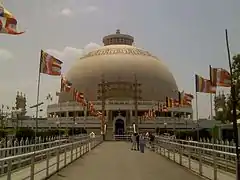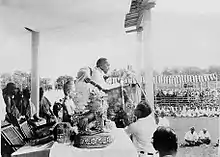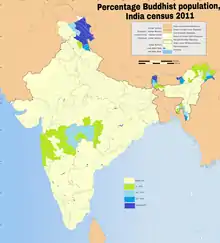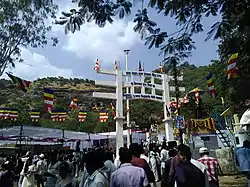Marathi Buddhists
Marathi Buddhists (मराठी बौद्ध; Marāṭhī Baud'dha) are Buddhists of Marathi ethnic and linguistic identity. The religious community resides in the Indian state of Maharashtra. They speak Marathi as their mother-tongue (first language). The Marathi Buddhist community is the largest Buddhist community in India. According to the 2011 Indian census, Marathi Buddhists constitute 5.81% of the population in Maharashtra, which is 77% of the total Buddhist population in India.[2]
मराठी बौद्ध (Marathi Bauddha) | |
|---|---|
 Deekshabhoomi monument, located in Nagpur, Maharashtra, where B. R. Ambedkar converted to Buddhism in 1956, is the largest stupa in Asia.[1] | |
| Total population | |
| Regions with significant populations | |
| Maharashtra | |
| Languages | |
| Marathi | |
| Religion | |
| Buddhism | |
| Related ethnic groups | |
| Mahars • Marathi people |
History

Almost all Marathi Buddhists belong to the Navayana tradition, a 20th-century Buddhist revival movement in India that received its most substantial impetus from B. R. Ambedkar who called for the conversion to Buddhism to escape a caste-based society that considered them to be the lowest in the hierarchy.[3]
B. R. Ambedkar publicly converted on 14 October 1956, at Deekshabhoomi, Nagpur, over 20 years after he declared his intent to convert. He converted approximately 600,000 people to Buddhism.[4] The conversion ceremony was attended by Medharathi, his main disciple Bhoj Dev Mudit, and Mahastvir Bodhanand's Sri Lankan successor, Bhante Pragyanand.[5] Ambedkar asked Dalits not to get entangled in the existing branches of Buddhism (Theravada, Mahayana and Vajrayana), and called his version Navayana or 'Neo-Buddhism'. Ambedkar would die less than two months later, just after finishing his definitive work on Buddhism. Many Buddhists employ the term "Ambedkarite Buddhism" to designate the Buddhist movement, which started with Ambedkar's conversion.[5] Converted people call themselves "-Bauddha" i.e. Buddhists.
Population

Almost all Marathi Buddhists are converts from Hinduism. Most Buddhist Marathi people belong to the former Mahar community who adopted Buddhism with Ambedkar in 1956.[6][7]
In the 1951 census of India, In Maharashtra, 2,487 (0.01%) respondents said they were Buddhist. The 1961 census, taken after B. R. Ambedkar adopted Navayana Buddhism with his millions of followers in 1956, showed an increased to 2,789,501 (7.05%).[8]
Marathi Buddhists account for 77.36% of all Buddhists in India.[2] According to the 2011 Census of India there are 6.5 million Buddhists in Maharashtra but Buddhist leaders claim there are about 10 to 12 million Buddhists in Maharashtra. Among cities Mumbai has largest Buddhist population accounting for 4.85% of total mumbai population. Almost 90 per cent of Navayana Buddhists live in the state.[9] 5,204,284 (79.68%) Marathi Buddhists belong to the Scheduled Caste category.[10]
Notable Marathi Buddhists
Business
- Milind Kamble, National President of DICCI[11]
- Kalpana Saroj (Born 1961), a female Indian entrepreneur and a Tedx speaker[12][13]
Law and Justice
- B. R. Ambedkar (1891-1956), Jurist, Barrister and, 1st Law and Justice Minister of India
- B. C. Kamble (born 1919), Jurist and Lawyer
- R. D. Bhandare (born 1916), Former Governor of Bihar and Andhra Pradesh
- Bhushan Gavai (born 1960), a Justice in the Supreme Court of India[14]
Literature and activism
- Savita Ambedkar (1909 – 2003), social activist and writer
- Raja Dhale (1940 – 2019), social activist and writer
- Namdeo Dhasal (1949 – 2014), social activist and writer
- Suresh Bhat (1932 – 2003), poet
- Gangadhar Pantawne, writer, reviewer and Ambedkarite thinker
- Shankarrao Kharat, writer and member of the MLC
- Dagdu Maruti Pawar, writer and poet
- Pradnya Daya Pawar, poet and fiction writer
- Arun Kamble, writer and social activist
- Baburao Bagul, writer and poet
- Uttam Kamble, an indian journalist
- Urmila Pawar, writer and activist
- Laxman Gaikwad, Famous novelist
- Vaman Kardak, poet and playwright
- Keshav Meshram, Poet
- Sharankumar Limbale, Author
- Rupa Kulkarni-Bodhi, Social Activist and writer[15]
Acting and Music
- Adarsh Shinde,Singer, Musician[16]
- Vitthal Umap, singer[17]
- Bhalchandra Kadam, actor, comedian[18]
- Bharat Jadhav, actor
- Siddhartha Jadhav, actor
- Abhijeet Sawant, actor and singer
- Kushal Badrike, actor, comedian
- Vaishali Mhade, singer
- Abhijeet Kosambi, singer
- Surekha Punekar, indian folk artist
- Prahlad Shinde, Singer
Politics
- B. R. Ambedkar, the Father of the Indian Constitution, 1st Law and Justice Minister, Member of the parliament
- Yashwant Ambedkar, Member of MLC
- Prakash Ambedkar, Member of the parliament
- Anandraj Ambedkar, political activist
- Ramdas Athawale, current state minister of India, and Member of the parliament
- Rajkumar Badole, Former Social Justice And Assistance Minister Maharashtra
- Bhaurao Gaikwad, Member of the parliament
- R. D. Bhandare, Former Governor of Bihar and Andhra Pradesh[19]
- R. S. Gavai, Former Governor Bihar And Kerala, Member of the parliament, Former Chairman of Maharashtra Legislative Council
- Nitin Raut, current Cabinet minister and MLA[20]
- Rajendra Gavai, political activist
- Jogendra Kawade, former cabinet minister, and Member of the Maharashtra Legislative Assembly
- Laxman Mane, political activist
- Eknath Gaikwad, MP and former state minister
- Varsha Gaikwad, current School Education Cabinet Minister of Maharashtra[21]
- Sulekha Kumbhare, former minister
- Sanjay Bansode, current state Minister of Maharashtra [22]
- Mukul Wasnik, former minister for social justice and Empowerment
- Jitendra Awhad, Cabinet Minister for Housing in Maharashtra government
- Tukaram Shrangare, Former Union Minister For State For Communications
- Murlidhar Chandrakant Bhandare, Former Governor of Odisha
- Sudhakar Tukaram Shrangare, Member of Parliament
- Sunil Gaikwad, Former Member of Parliament
- Sharad Bansode , Former Member of Parliament
- Prakash Gajbhiye , Former Member of MLC
- Nashikrao Tirpude, Former 1st Deputy Chief Minister of Maharashtra
- Ramratan Janorkar, Former Mayor of Nagpur
- Suresh Mane, Indian Politicians
- Waman Meshram, President Of Bahujan Kranti Morcha
- B. D. Khobragade, Deputy Chairman of the Rajya Sabha[23]
- Balkrishna Ramchandra Wasnik, Former Member of Parliament from Bhandara and Buldhana
- Avinash Mahatekar, Former State Minister Of Maharashtra[24][25]
- Chandrakant Handore, Former Minister Of Maharashtra[26][27]
- Dadasaheb Rupwate, Indian Politician
Scientists in various fields
- Narendra Jadhav, economist, educationist and author
- Bhalchandra Mungekar, economist and author
- Sukhadeo Thorat, economist and author
- Shankarrao Kharat, Former Vice Chancellor Of Dr BAMU Aurangabad
Sports
- Mona Meshram, Indian Cricketer
- Avinash Sable, Indian Athlete
- Arundhati Pantawane, Indian Batminton Player
- K. D. Jadhav, Indian Athlete
- Sunil Jadhav, Indian Body Builder
Culture

Festivals
- Buddha Purnima, is Public Holiday In Maharashtra
- Babasaheb Ambedkar Jayanti, is a public holiday in Maharashtra, India.
- Dhammachakra Pravartan Day is a public holiday in Maharashtra, India.
- Vesak is a public holiday in Maharashtra, India.
References
- Bhagwat, Ramu (19 December 2001). "Ambedkar memorial set up at Deekshabhoomi". Times of India. Retrieved 1 July 2013.
- "Population by religion community – 2011". Census of India, 2011. The Registrar General & Census Commissioner, India. Archived from the original on 25 August 2015.
- Thomas Pantham; Vrajendra Raj Mehta; Vrajendra Raj Mehta (2006). Political Ideas in Modern India: thematic explorations. Sage Publications. p. 48. ISBN 0-7619-3420-0.
- Robert E. Buswell Jr.; Donald S. Lopez Jr. (2013). The Princeton Dictionary of Buddhism. Princeton University Press. p. 34. ISBN 978-1-4008-4805-8.
- Bellwinkel-Schempp, Maren (2004). "Roots of Ambedkar Buddhism in Kanpur" (PDF). In Jondhale, Surendra; Beltz, Johannes (eds.). Reconstructing the World: B.R. Ambedkar and Buddhism in India (PDF). New Delhi: Oxford University Press. pp. 221–244. Archived from the original on 1 August 2012.CS1 maint: bot: original URL status unknown (link)
- Jaffrelot, Christophe (2005). "The 'Solution' of Conversion". Dr Ambedkar and Untouchability: Analysing and Fighting Caste. Orient Blackswan Publisher. pp. 119–131. ISBN 8178241560.
- Zelliot, Eleanor (1978). "Religion and Legitimation in the Mahar Movement". In Smith, Bardwell L. (ed.). Religion and the Legitimation of Power in South Asia. Leiden: Brill. pp. 88–90. ISBN 9004056742.
- Kantowsky, Detlef (1997). Buddhisten in Indien heute, Indica et Tibetica 30, 111
- "INDIA Indian Buddhists reject religious census". m.asianews.it.
- "बौद्ध बढ़े, चुनावी चर्चे में चढ़े". aajtak.intoday.in (in Hindi). Retrieved 30 January 2018.
- https://mumbaimirror.indiatimes.com/others/sunday-read/the-buddhism broadcast/articleshow/64716857.cms
- Pronoti, Datta (29 May 2010). "Caste No Bar". The Crest Mumbai. Archived from the original on 16 January 2018. Retrieved 12 November 2019.
- "Kalpana – Symbol of true grit". The Hans India. Retrieved 2018-01-16.
- Sikka, Sonia; Puri, Bindu; Beaman, Lori G. (2015-08-11). Living with Religious Diversity. Routledge. ISBN 9781317370987.
- https://www.mid-day.com/articles/sumedha-raikar-mhatre-why-we-chose-the-buddha/19370176
- https://www.bhaskar.com/maharashtra/pune/news/MH-PUN-HMU-wedding-pics-of-well-known-singer-adarsh-shinde-5007221-PHO.html
- https://divyamarathi.bhaskar.com/news/MAG-samir-paranjape-rasik-article-in-marathi-5473432-NOR.html
- https://www.dnaindia.com/india/report-in-the-shadow-of-caste-2547684
- https://books.google.co.in/books?id=KK0_AAAAMAAJ&q=%E0%A4%B0%E0%A4%BE%E0%A4%AE%E0%A4%9A%E0%A4%82%E0%A4%A6%E0%A5%8D%E0%A4%B0+%E0%A4%A7%E0%A5%8B%E0%A4%82%E0%A4%A1%E0%A5%80%E0%A4%AC%E0%A4%BE+%E0%A4%AD%E0%A4%82%E0%A4%A1%E0%A4%BE%E0%A4%B0%E0%A5%87+%E0%A4%AC%E0%A5%8C%E0%A4%A6%E0%A5%8D%E0%A4%A7&dq=%E0%A4%B0%E0%A4%BE%E0%A4%AE%E0%A4%9A%E0%A4%82%E0%A4%A6%E0%A5%8D%E0%A4%B0+%E0%A4%A7%E0%A5%8B%E0%A4%82%E0%A4%A1%E0%A5%80%E0%A4%AC%E0%A4%BE+%E0%A4%AD%E0%A4%82%E0%A4%A1%E0%A4%BE%E0%A4%B0%E0%A5%87+%E0%A4%AC%E0%A5%8C%E0%A4%A6%E0%A5%8D%E0%A4%A7&hl=en&sa=X&ved=2ahUKEwjh2e6Bi6PuAhVMxTgGHdR-DFMQ6AEwAHoECAMQAg
- https://divyamarathi.bhaskar.com/news/23-ministers-belong-to-the-maratha-community-in-thackeray-government-126408482.html
- https://divyamarathi.bhaskar.com/news/23-ministers-belong-to-the-maratha-community-in-thackeray-government-126408482.html
- https://divyamarathi.bhaskar.com/news/23-ministers-belong-to-the-maratha-community-in-thackeray-government-126408482.html
- https://en.m.wikipedia.org/wiki/B._D._Khobragade
- https://www.sarkarnama.in/rpi-claims-phaltan-seat-say-avinash-mahatekar-42223
- https://www.nagpurtoday.in/minister-of-social-welfare-avinash-mahatekar-visited-dikshit-bhoomi/07191927
- Teltumbde, Anand. "Bombay High Court's 'Dalit' ruling has come in handy for the politics of Hindutva". Scroll.in.
- "Cabinet off-limits for sons & daughters - Indian Express". archive.indianexpress.com.
